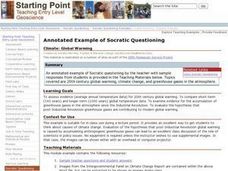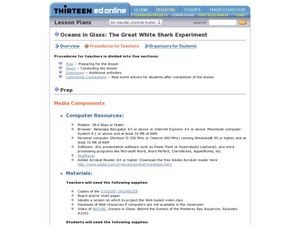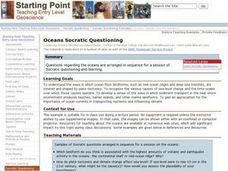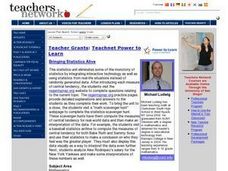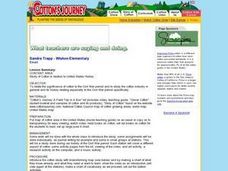Curated OER
Annotated Example of Socratic Questioning: Climate: Global Warming
Learners compare and discuss short-term and longer-term global temperature data. They evaluate data from three sets of graphs and then participate in a structured whole class Socratic discussion on the possible causes of climate change.
Curated OER
Let Your Fingers Do The Walking
Students build an awareness of using correct finger positions for typing in this activity. They also review the home row of the keyboard. Internet resource links are included to reinforce home row typing skills. Students also access...
Curated OER
Oceans in Glass: The Great White Shark Experiment
Young scholars use the Internet to study great white sharks and answer questions. In this ocean lesson students create and produce a website that summarizes the information they obtained in their research.
Curated OER
Greek Golden Age
Sixth graders study the Greek Golden Age. In this ancient Greece lesson, 6th graders explore a virtual Greek theater and complete reading, writing, and drawing activities in classroom learning stations.
Curated OER
Technology - money
First graders trade coin amounts by using punch out coins. In this trading coins lesson plan, 1st graders use pennies, nickels, and dimes, and then trade them with each other in equivalent amounts. Students also complete money computer...
Curated OER
Wealth and Power: United States v. Microsoft
High schoolers explore wealth and influence in the United States. In this Bill of Rights instructional activity, students listen to their instructor present a lecture regarding the details of the United States v. Microsoft...
Curated OER
Making a Spreadsheet
Young scholars explore spreadsheet software. In this personal finance and computer technology activity, students develop a vacation spreadsheet on the computer. Young scholars represent hotel, food, transportation, and...
Alabama Learning Exchange
Writing Thank-You Notes
Students write thank-you notes using the writing process. They draft, revise, edit, and publish their thank-you notes and use a computer to view examples of thank-you notes and insert graphics into their own published thank-you notes.
Curated OER
Assembling A Story
Students observe, discuss, and interpret Radcliffe Bailey's work "By the River" by creating a personal narrative of the 18th or 19th century. Internet access is required and related links are offered for teaching aides.
Curated OER
Math Games
Fourth graders participate in a lesson plan that is involved in the breaking of codes using computer games. They access the internet to play math games. The teacher uses powerpoint to help guide students with common problems in loading...
Curated OER
Oceans Socratic Questioning
Students participate in a whole class discussion of ocean-floor structures and plate tectonics. They respond to prompts in a structured sequence that lead them to conclusions about the role of plate tectonics in the creation of sea-floor...
Curated OER
Describe and Interpret Images: Folded Strata
Pupils describe and interpret images. They make a simple sketch of an outcrop shown in a slide (or computer projection) then discuss possible interpretations.
Curated OER
Get Ready/Burns' Warm Up
Middle schoolers in P.E. class organize into squads. Displayed on a computer screen are a given set of warm-up exercises. Each squad runs up, reads the directions, completes the warm-up and then runs back up to read another set of...
Curated OER
So Much To Do, So Little Time
Students explore how people dividde their time among different tasks and the effect that computer technology has had on this practice. Students write their experiences with multitaskinging. They explore how multitasking has affected...
Curated OER
Bringing Statistics Alive
Students compute mean, median and mode and compare mean, median and mode to a real-world application to identify their practical uses. They apply mean, median and mode to real-world statistical data. Finally, students organize data into...
Curated OER
The Harlem Renaissance: Awakening the Black Soul
Eleventh graders explore, examine and study about the impact of the Harlem Renaissance on the American culture. They assess and explain how the Harlem Renaissance was a "rebirth" for the African American culture through art, music, and...
Curated OER
Squashing the Millennium Bug
Students evaluate the roles that technology plays in the many aspects of daily life in our technological world and the potential problems that may arise due to the Year 2000 situation.
Curated OER
Cotton Journey
Students use "Cotton Journey-A Field Trip In A Box" kit to relate the significance of cotton to the Civil War period and to study the cotton industry in general.
Curated OER
Non-Fiction Animal Picture Books
Students complete a multi-lesson unit using research to create their own book about an animal of their choice. After discussing the elements of non-fiction texts, they use internet research to explore an animal of interest to them. ...
Curated OER
Fair Game?
Students evaluate possible gender stereotypes perpetuated by computer games, particularly those designed for girls. They design a prototype for a gender bias-free computer game that would appeal to both males and females.
Curated OER
Biosphere Socratic Questions
Students examine the origin of life on Earth and its evolution through geologic time by participating in a whole class discussion. They respond to prompts that lead them to conclusions about the interactions among the biosphere and the...
Curated OER
ICT Activity 18
Eighth graders study the 'Rime of the Ancient Mariner.' They study the ballad and explore style and technique. Students use the internet and search previously identified news sites for current items of interest. They use images copied...
Curated OER
A Statistical Look at Jewish History.
Eighth graders study the relationship between fractions, decimals and percentages by completing activities. In this research analysis lesson, 8th graders look at different websites to figure out Jewish populations in different situations.
Curated OER
It's Not Your Fault
Students study the San Andreas Fault, calculate its movements, and compare the movements on both sides. In this earthquake lesson students use the Internet to track movement, and calculate movement using a spreadsheet.
